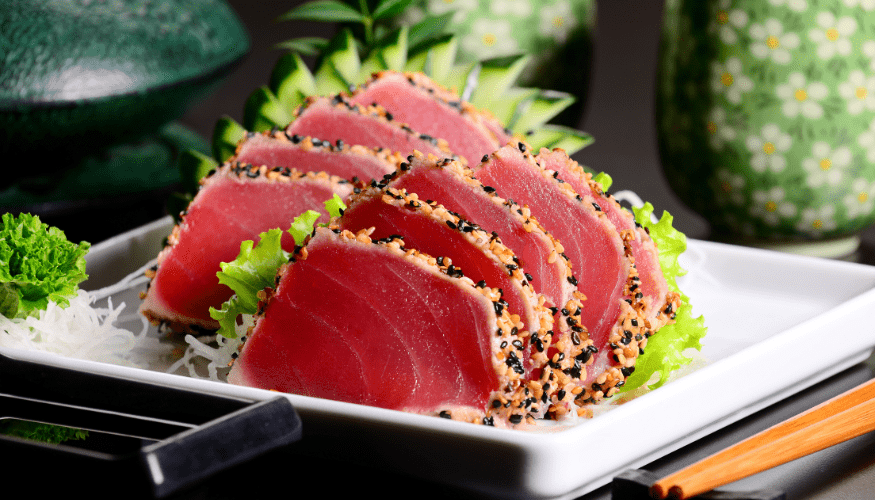Tuna Sashimi is the ultimate dish features thinly sliced, sushi-grade tuna, beautifully plated to showcase its vibrant red hue. The clean, delicate flavor of the tuna is complemented by a touch of soy sauce, wasabi, and a sprinkle of sesame seeds for added texture.

What is Tuna Sashimi?
Tuna sashimi is the Japanese dish consisting of thinly sliced raw tuna, usually served without rice, unlike sushi. The term “sashimi” itself refers to any kind of raw fish or seafood served in thin slices, paired with dipping sauces such as soy sauce and wasabi. The primary ingredient, in this case, is tuna, known for its deep red color and firm texture. Depending on where it is sourced, tuna can range from light pink to dark crimson.
Whether you’re enjoying fatty tuna (otoro), lean tuna (akami), or a balance of both, the experience of tuna sashimi offers unparalleled freshness and flavor.
Tips and Tricks for the Perfect Tuna Sashimi
When it comes to tuna sashimi, quality and freshness are key. Here are a few tips to ensure your tuna sashimi is always top-notch:
Choose Fresh Tuna: The freshness of the tuna directly impacts the taste of your sashimi. Always look for bright red or deep pink tuna with a clean, ocean-like smell. A reputable fishmonger is your best source for high-quality tuna.
Opt for Sashimi-Grade Tuna: This is a designation used for tuna that is safe to eat raw. Look for fish that has been frozen to kill any parasites, which is required by law in many countries to ensure safety when consuming raw fish.
Slice at an Angle: The texture of sashimi depends on the way the fish is cut. Always cut your tuna at a 45-degree angle against the grain to achieve the desired melt-in-your-mouth texture.
Keep it Cold: Tuna is best served chilled. After slicing the fish, ensure that it’s kept on a cold plate or over ice, as this will maintain its freshness.
Use a Sharp Knife: A sharp, high-quality knife ensures clean cuts. Dull knives can tear the flesh of the fish, which affects the presentation and texture.
Serve Immediately: For the best experience, serve your tuna sashimi as soon as it’s prepared. Tuna’s delicate nature means it’s best enjoyed fresh.

Variations of Tuna Sashimi
While traditional tuna sashimi is incredibly satisfying on its own, you can get creative with different styles and accompaniments to elevate the dish.
Tuna Sashimi with Yuzu Kosho: Adding a citrusy, spicy yuzu kosho (a Japanese condiment made with yuzu zest and chili peppers) gives the sashimi an extra kick, balancing the rich flavor of the tuna.
Tuna Sashimi with Truffle Oil: If you’re looking for a luxurious twist, a light drizzle of truffle oil paired with tuna sashimi adds a depth of flavor that is irresistible.
Tuna Sashimi Salad: For a lighter option, you can serve tuna sashimi on a bed of mixed greens with a simple dressing of sesame oil, soy sauce, and rice vinegar. This offers a refreshing contrast to the richness of the tuna.
Spicy Tuna Sashimi: Dice your tuna into small cubes and mix it with spicy mayo or chili paste for a zesty variation. This spicy tuna mixture is often used in sushi rolls but can be served on its own as a bold twist on traditional sashimi.
Tuna Sashimi with Avocado: Pairing fresh tuna sashimi with creamy avocado adds richness to the dish and provides a delightful contrast in texture.
How to Serve Tuna Sashimi
Tuna sashimi is best served with minimal garnish to allow the natural flavor of the fish to shine. Here are a few ideas on how to serve it:
- Classic Presentation: Arrange the tuna slices in a fan-like shape on a chilled plate, with a dollop of wasabi and a small dish of soy sauce on the side. For an added touch, you can include thin slices of daikon radish for garnish.
- Accompaniments: To enhance the experience, serve with a small amount of pickled ginger and soy sauce for dipping. If you enjoy spicy flavors, wasabi or chili-infused soy sauce can add an extra layer of heat.
- Garnishes: While traditional sashimi is served plain, you can add garnishes like chopped green onions, sesame seeds, or even a sprinkle of seaweed flakes for added flavor.
How to Store Tuna Sashimi
Tuna sashimi should always be consumed as soon as it is prepared to enjoy its full flavor. However, if you need to store leftover tuna sashimi, here are some tips:
- Keep it Chilled: Always refrigerate leftover tuna sashimi immediately. Wrap it tightly in plastic wrap or store it in an airtight container to prevent exposure to air and moisture.
- Use Within 24 Hours: Tuna sashimi is best enjoyed within a day of preparation. After that, the texture and freshness of the tuna may deteriorate.
- Freezing: If you plan to store sashimi for a longer period, you can freeze the tuna. Make sure to wrap the fish tightly and place it in a freezer-safe container. When ready to eat, thaw it in the fridge overnight. Freezing can slightly alter the texture, but it will still be safe to consume.

Recipe FAQs
1. Can I make tuna sashimi at home?
Yes! As long as you source sashimi-grade tuna, making tuna sashimi at home is simple. The most important factors are freshness, quality, and the proper cutting technique.
2. How do I choose the best tuna for sashimi?
Look for tuna that is labeled “sashimi-grade” from a trusted source. This ensures that the tuna has been handled properly and is safe for raw consumption. The fish should have a deep red color, firm texture, and no unpleasant odor.
3. Is tuna sashimi healthy?
Yes, tuna is a great source of protein, omega-3 fatty acids, and essential vitamins and minerals. However, be mindful of the mercury levels in tuna, especially for pregnant women and young children. Opt for a variety of tuna like bluefin or yellowfin to balance your consumption.
4. What is the difference between sashimi and sushi?
Sashimi refers to raw fish served without rice, while sushi includes raw or cooked fish served with vinegared rice. Sushi can also include other ingredients like vegetables, nori (seaweed), and toppings.
5. Can I use frozen tuna for sashimi?
Yes, using frozen tuna is perfectly fine for sashimi, provided it has been frozen to the appropriate temperature to kill parasites. Always check that your tuna is labeled “sashimi-grade” to ensure its safety.
Tuna Sashimi

Tuna Sashimi is the ultimate dish features thinly sliced, sushi-grade tuna, beautifully plated to showcase its vibrant red hue.
Ingredients
- 200 g tuna sashimi-grade tuna
- Juice of 2 limes
- 1 tbsp freshly grated ginger
- 1 tbsp soy sauce
- 1 tsp honey
- Scallions, thinly sliced, for garnish
- Sesame seeds, for garnish
Instructions
- Start by whisking together lime juice, grated ginger, soy sauce, and honey in a small bowl to create a tangy dressing.
- Next, arrange the fresh, sliced tuna on a plate, and generously drizzle the ginger-lime dressing over the fish.
- Finish off with a sprinkle of thinly sliced scallions and a handful of sesame seeds for a crunchy, flavorful garnish.
- And there you have it—an easy, no-cook tuna sashimi that’s sure to impress. Perfect for a light appetizer or a refreshing main dish!
Nutrition Information
Yield
3Serving Size
1Amount Per Serving Calories 233Total Fat 5gSaturated Fat 1gTrans Fat 0gUnsaturated Fat 4gCholesterol 39mgSodium 390mgCarbohydrates 21gFiber 3gSugar 12gProtein 27g
Easy Shrimp Recipes.com, occasionally offers nutritional information for recipes contained on this site. This information is provided as a courtesy and is an estimate only. This information comes from online calculators. Although allchickenrecipes.com attempts to provide accurate nutritional information, these figures are only estimates.
Conclusion
Tuna sashimi is the epitome of fresh, flavorful seafood and a dish that embodies the simplicity and elegance of Japanese cuisine. Whether you’re a sushi connoisseur or trying your hand at sashimi for the first time, the tips and techniques we’ve covered will help you master this dish at home. From selecting the right tuna to experimenting with fun variations, tuna sashimi is a versatile and delicious dish that can elevate any meal. Enjoy the process, and most importantly, savor the fresh, clean flavors that come with every slice of this exquisite dish.
Try these other tuna recipes:

